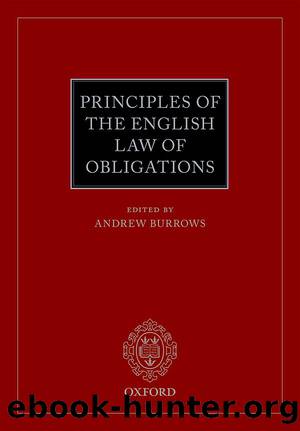Principles of the English Law of Obligations by Burrows Andrew;

Author:Burrows, Andrew; [Burrows, Andrew]
Language: eng
Format: epub
Publisher: Oxford University Press, Incorporated
F. Strict Liability: Interference with Property Rights
2.301 The lawâs protection of property rights has two aspects. There is first the protection of the claimantâs right to the physical integrity of his assets. Here the law lays down what it will do about damage. Then there is the protection of the right to control the asset, where the law says what it will do when another person assumes control without consent, as for instance by finding, or taking, or buying from a non-owner.
2.302 When a chattel or land is damaged, redress is usually sought through the tort of negligence, although it may also be sought in trespass, which was formerly the dominant wrong. Unlike negligence, trespass liability is strict although the act must be willed. This has already been considered.586 The primary tort in relation to interference with chattels is now conversion, which focuses upon interferences with control. The first two subsections are concerned only with corporeal property. The third section deals briefly with incorporeals.
(1) Common Law
(a) No vindicatio at common law
2.303 In classical Roman law a claimant could go to court and make a direct assertion of his ownership of the asset in question: âThat cow, Buttercup, is mine!â That assertion was called the vindicatio.587 Such a claim has nothing to do with the law of torts or civil wrongs. It is a pure proprietary claim, in that it is nothing other than the assertion of the proprietary right. There is probably no system in which such a pure proprietary claim does all the work of protecting this right. But in some it stands in the front line.
2.304 In English law, on the common law side, if it comes to litigation, there is no vindicatio. Outside the court there is nothing to prevent the claimant saying, âThat cow, Buttercup, is mine!â The person in possession may concede and surrender Buttercup. Within imperfectly defined limits, the claimant can also have recourse to self-help to take back his asset.588 However the common law simply does not recognize a demand in court which consists in the direct assertion of ownership. There is, in this sense, no pure proprietary remedy, no vindicatio.
2.305 The one exception to this might be said to be the action to recover land, formerly the action of ejectment. In the early days of the common law the writ of right and the writs of entry might have been said to be pure proprietary claims, with the additional and exceptional feature, unknown to the classical vindicatio, that judgment would be for the surrender of possession of the thing itself.589 However, the real actions gave way to a special action of trespass with force and arms which was in turn in due course equipped with that characteristic which gave the real actions their name, the order to surrender the thing itself.590 Statutory reforms, first as part of the abolition of the forms of action and then aimed to speed up the recovery of possession against squatters, have broken every meaningful link with the tort of trespass.
Download
This site does not store any files on its server. We only index and link to content provided by other sites. Please contact the content providers to delete copyright contents if any and email us, we'll remove relevant links or contents immediately.
The Social Psychology of Inequality by Unknown(2312)
The Plant Paradox by Dr. Steven R. Gundry M.D(2043)
The Writing on the Wall by Anselm Jappe(1759)
Working for Yourself by J.D. (Nolo) Stephen Fishman(1479)
Every Landlord's Legal Guide by Janet Portman & Stewart Marcia & Ralph Warner(1326)
The First 20 Hours: How to Learn Anything ... Fast by Kaufman Josh(1304)
ADHD on Trial by Michael Gordon(1241)
Decisive by Chip Heath(1202)
Drafting Contracts: How and Why Lawyers Do What They Do, Second Edition by Stark Tina L(1174)
Working for Yourself by Stephen Fishman J.D. (Nolo)(1140)
The Economist Aug 8th 2015 by The Economist(1123)
Restitution by Restitution(1116)
The Economist Aug 29th 2015 by The Economist(1098)
A Practical Guide to International Arbitration in London by Hilary Heilbron(1085)
The Lord of the Rings: The Fellowship of the Ring, the Two Towers, the Return of the King by J. R. R. Tolkien(1083)
Intellectual Property Strategy by John Palfrey(1082)
Collusion by Luke Harding(1045)
Persuasion by Owner(1014)
Chapter 1 by Owner(950)
